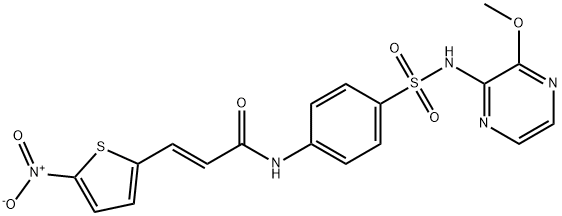Description
Necrosulfonamide (1360614-48-7) specifically blocks necroptosis downstream of RIP3 activation by preventing MLKL-RIP3 interaction.1 Displays neuroprotective effects after ischemic brain injury.2 Prevents cystine-starvation-induced necroptosis and ferroptosis in human triple negative breast cancer cells.3 Binds to gasdermin D inhibiting pyroptosis and associated inflammatory cell death and sepsis.4 Rescues cells from TLR3 ligand-induced death.5
Uses
Necrosulfonamide is a necroptosis inhibitor. Necrosulfonamide is a pharmacological inhibitor of mixed lineage kinase domain-like protein (MLKL).
Definition
ChEBI: Necrosulfonamide is a sulfonamide that is a 3-methoxypyrazin-2-yl derivative of (E)-N-(4-(N-(4,6-dimethylpyrimidin-2-yl)sulfamoyl)phenyl)-3-(5-nitrothiophene-2-yl)acrylamide. Necrosulfonamide specifically blocks necrosis downstream of the activation of RIP3 (the receptor-interacting serine-threonine kinase 3), a key signalling molecule in the programmed necrosis (necroptosis) pathway. It is a sulfonamide, a member of pyrazines and a member of thiophenes.
References
1) Sun et al. (2012) Mixed lineage kinase domain-like protein mediates necrosis signaling downstream of RIP3 kinase; Cell 148 213
2) Zhou et al. (2017) The degradation of mixed linage kinase domain-like protein promotes neuroprotection after ischemic brain injury; Oncotarget, 8 68393
3) Chen et al. (2017) CHAC1 degradation of glutathione enhances cysteine-starvation-induced necroptosis and ferroptosis in human triple negative breast cancer cells via the GCN2-elF2α-ATF4 pathway; Oncotarget, 8 114588
4) Rathkey et al. (2018) Chemical disruption of the pyroptotic pore-forming protein gasdermin D inhibits inflammatory cell death and sepsis; Sci Immunol., 3 eaat2738
5) Cuchet-Lourenco et al. (2018) Biallelic RIPK1 mutations in humans cause severe immunodeficiency, arthritis, and intestinal inflammation; Science, 361 810

